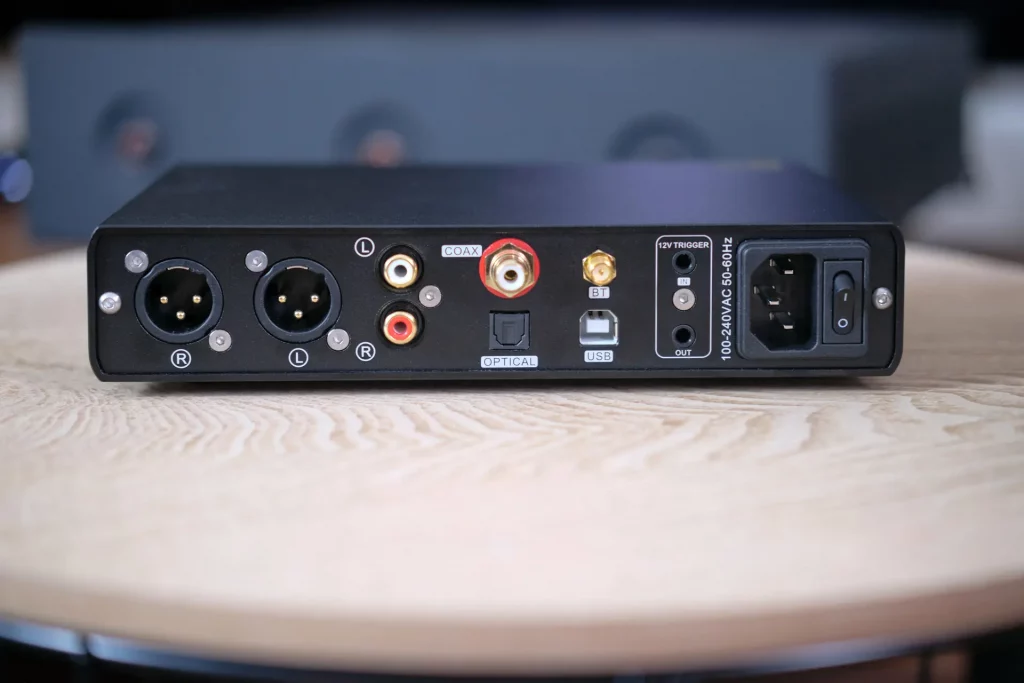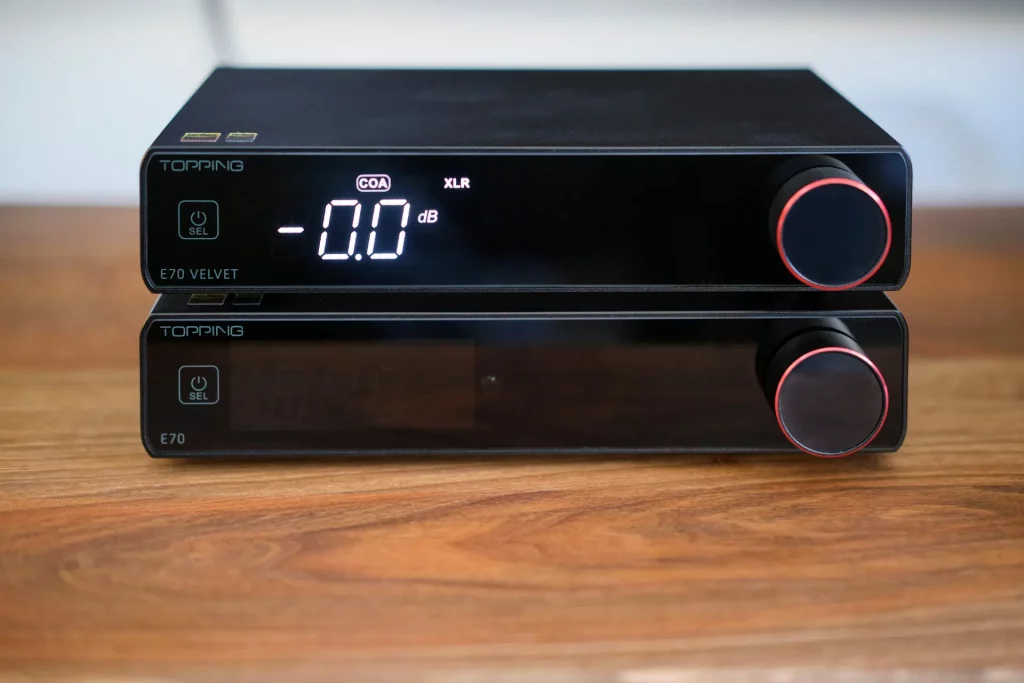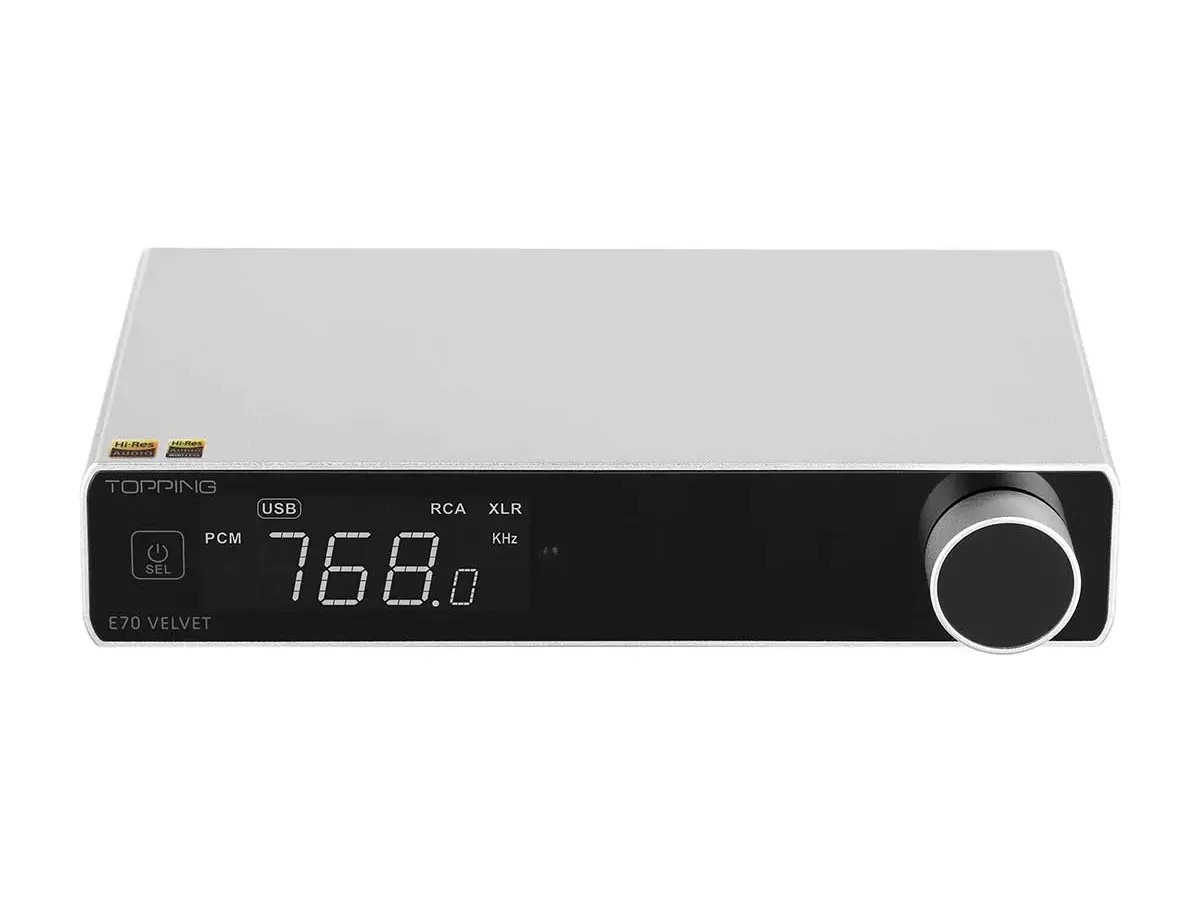Topping has established itself as a well-known name amongst good and affordable products, but E70 velvet faces some seriously skilled competition at its price. So let’s not lose our time by making this intro longer than it needs to be and let’s get this review going.
Build and Features
Topping E70 velvet follows the design language of its predecessor E30 and E50. This means that most of the device is wrapped inside an aluminum casing that comes in either black or silver. The front panel is always black and made out of scratch-resistant glass. You control it using a touch-sensitive button on the left and a volume knob that doubles as a button on the right. A small remote control is also onboard which is useful for choosing inputs and changing volume without moving from the sofa.
In the back, we see the usual digital inputs such as USB, optical, and coaxial, but there’s also Bluetooth onboard. Regarding analog outs, we can choose between single-ended RCA and balanced XLR ones. Both of these can be used in a fixed or variable output level mode. AC power connector on the right means that E70 velvet is powered directly from the wall socket and there’s no need for an AC/DC adapter.


As you can see in the second image, the E70 velvet looks exactly the same as the regular E70. The difference is hidden inside where E70 velvet is based around an AKM DAC chip instead of the Sabre one inside the non-velvet version. And it’s not just any AKM chip but their flagship AK4499EX. A powerful signal processor in the form of XMOS XU-316 has been used too, enabling the highest possible PCM and DSD resolutions. But the chips being used are only one part of the story. The sound of a DAC as a whole device depends as much on the quality of the power supply and the output stage. Topping doesn’t say much about these but that’s why you have me – to put it through the real-life test and see how it performs.
Sound
Luckily, Topping E70 velvet doesn’t disappoint. Just like its non-velvet E70, it also sounds naturally lush and full. The bassline, midbass included, is deep and pleasantly warm. This lends a slight warmth and richness to the midrange which is a welcome change from some colder and analytical Toppings of old. This results in the richest and most natural tone timbre that I’ve ever heard on a Topping DAC so far. But if you think that they sacrificed detail retrieval for it, you’re wrong. E70 velvet is a very transparent and detail-rich sounding DAC. This goes for clean edges and transient, but also for the rich inner-tone texture. Highs are well-extended, open, and airy, avoiding any sort of hardness or harshness. There’s nothing to complain about E70 velvet’s tonality really, it’s a skillful balance between gentle warmth and transparency that provides a very natural and pleasant sound signature.
The soundstaging is very good too, E70 velvet spreads and layers all tones in a respectably wide and airy soundstage. Perception of depth is not its strong suit but basically no DAC at this price point can do it much better so I can’t hold that against it. Dynamics are good and this Topping sounds alive and engaging thanks to it. It has enough speed to follow the fast rhythm if needed but it will never sound relentless, analytical, or mechanically precise. No, E70 velvet is actually a very smooth-sounding DAC that gets musical flow better than any Topping before it no matter the price.
Comparisons
Topping E70 without any suffix means that we’re talking about the $100 cheaper Sabre version. These two share the looks but also they share most of their sound signature too. Both are slightly warm, very smooth, full-bodied, and rich in tone timbre. The difference kicks in mostly in the upper parts of the frequency spectrum where E70 is somewhat darker sounding. E70 velvet feels more open, more airy, and in the process reveals a bit more about what’s going on in the recording in those upper parts. That’s all there is to it and I have to say that I did prefer the velvet version for its open and more revealing upper registers. But if your system is overly bright already, you might as well go with a more affordable and darker E70.
SMSL SU-9 pro that I tested just before this one is its biggest opponent currently on the market. This SMSL DAC is absolutely great and I scored it appropriately. But here’s the thing, E70 velvet is great too. No matter how many times I compared them I couldn’t choose an outright winner here. SU-9 pro has a slightly more laid-back midrange, and because of that some vocals and instruments might appear more laid back in the soundstage too. E70 velvet has a more forward presentation with a slightly fuller and warmer midrange that appears closer to the listener. Everything else is comparable: dynamics, detail retrieval, good tone timbre, etc. Just think about that slightly different midrange presentation and choose your poison. You won’t make a mistake no matter which one you choose.
If you would like me to compare E70 Velvet to some older toppings like D90LE or D70s, unfortunately, I don’t have them with me anymore to do a direct comparison. That said, I remember D90LE being slightly more punchy and dynamic, but also a bit more strident and etched around the note edges. E70 velvet is more relaxed and musical sounding. D70s sounded very clean and linear, but I find E70 velvet to have a more natural tone timbre, slightly warmer midrange but more airy highs, and richer inner tone detail. I prefer those qualities and I would choose E70 velvet over D70s without a doubt.
Conclusion
The solid build is nothing new with Topping, detail retrieval and good value have also been on the table since the brand’s beginnings. What’s new is this more mature and natural approach to the overall sound signature. This is one of the most musical Toppings ever released, and also one of the best DACs that I ever tested up to 500 dollars.
| TOPPING E70 VELVET – CHARACTERISTICS |
|
DAC chip: AK4499EX |






Hi.
In regard to the E70Velvets auto on/off.
Does this work when connected from the TV via the optical to the E70 ?
And maybe you could answer this for me.
Spotify app on the TV
Spotify app on my phone
Spotify app on my computer
Is there any difference.
I noticed when using BT from my computer to Klipsch the fives the second was noticeable better.
You’re thoughts on using the E70Velvet from the TV to my AE1 Active’s would be greatly appreciated.
Love the YouTube Channel.
Thanks Andrew
With my TV Auto ON/OFF worked just fine over optical input. As for Spotify, I don’t really use it so can’t answer those questions, but generally speaking, a platform that runs the app and plays the music can make a difference. Not all devices that can run a piece of software do it equally well and send equally clean digital signal to your DAC.
Hi and first of all a big thank you for the reviews and effort. I love listening to your descriptions and the vocabulary you use. I can say the best reviews I’ve heard about audio equipment.
I’m in doubt between the E70 and the E70 Velvet and I can listen them in the store, but I’m even more in doubt between them and the Schiit Modi Multibit 2. I looked at many of your reviews along with those about these dacs and formed some impression. Since there is no review of MMB2, I assume you haven’t listened to it. I’m curious if you remember how the MMB1 compares to the E70 Velvet. Does the E70 V have depth, that palpable sound, 3d feeling and spacial thickness like MMB1. I love how you described the boldness and texture of the multibit. According to some sound demos and comments, MMB1 seems bit dark to me, which should not be the case with MMB2. What I’m looking for is a more ‘analog’ sound, I like the description of multibit, thickness, palpability, dimensionality, but I also like the micro details and resolution that the E70 should provide, especially in higher frequencies and not rolled off. The question is is the E70V as musical and entertaining as the multibit. According to the comments, MMB2 should be more detailed and an upgrade compared to MMB1. I can also find it for 100€ less than the E70V. I’m actually interested in a comparison of the multibit and the E70V if that’s even possible to answer…
The system I have is a tube preamp and amp and Verum 1 (also great review of great headphones that helped me buy) and Grado Hemp headphones
Having compared the E70V against the older D70s I would beg to differ on your conclusion: The E70V sounds a bit fuller and tonally richer compared to the D70s, that´s correct. But the D70s is better in PRAT, macro- and micro-dynamics and depth of soundstage, so I wouldn´t exactly call it a clear upgrade but more a step sideways in a different direction, at least in my perception. I will return the E70V which I have here for comparison and keep the D70s!
Thanks for the review anyways & Keep up the good work 🙂
Hi, does anyone know, when testing DAC’s does Srboljub use balanced or single ended connection?
They can be quite different.
Thanks – John
Hi John, I usually try both where both exist. Balanced is usually slightly better given that interconnect cable quality is the same for both.
Hello. I mainly listen to streaming music Amazon Music with iPad directly connected to my Harman kardon 3380 stereo receiver and paired with B & W 706 s2 speakers. This setup sometimes sounds bright to me . Can the Topping E 70 Velvet suit this setup ? Thanks in advance for your suggestions.